
|   |

|   |
September 1, 2016 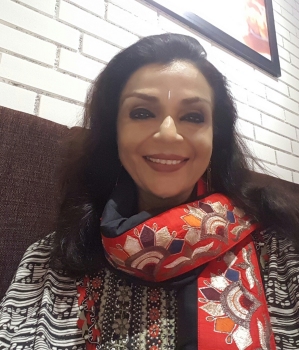
"When the whole world says "MOVE" You plant your feet firmly like a tree And say "NO. YOU MOVE." Lines from the film CAPTAIN AMERICA: CIVIL WAR These thoughts come to you from a month of watching, absorbing and reflecting on a variety of performances, venues, cities and people I have met and interacted with. I started this editorial on the flight to Colombo, continued it in Singapore and completed it in Kuala Lumpur. In all three cities/countries, I was starkly reminded of the fascinating history and achievements of the Tamil communities. Their long struggle under colonial rule through generations of oppression and marginalisation forced them to find cultural moorings for their own psyche. The answer for many lay in music and dance. It was not just in the building of temples and shrines, but in their steadfast loyalty to the Tamizh tongue via the cultural conduit of Bharatanatyam, ritual hymns and of course, movies that buoyed the millions of diaspora immigrants through their dark and brutal early years. Today, dance and music lives on in the homes and lives of the Tamil people around the world, the Sri Lankan Tamils being among the most faithful and active. However, it was not Bharatanatyam that I watched in the month of August. In fact, there was not a single performance of BN that I attended, although festivals and premieres were occurring almost every single day somewhere on the planet and in my home town of Madras/Chennai. #BLACK SUN - Sardono Wayulo Kusumo – Singapore 
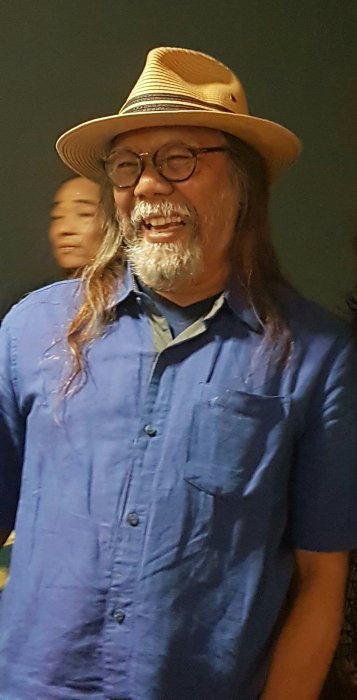 Indonesia's Sardono is a gift to world theatre. Much like our very own Ratan Thiyam, this genius artiste and visual genius has stirred much of the world with his searing commentaries on the environment and spiralling chaos of his native Indonesia. At 71, he continues to inspire audiences with his stunning and uncomfortable reminders of our brief time on earth. This painter, choreographer, modern dance maverick displays a perfumed silkiness in his opening visuals. Demure Javanese court dancers can tiptoe onto the stage wearing traditional robes and then take revolvers from under their batik sarongs and shoot! His latest offering for the 2016 SINGAPORE ARTS FESTIVAL (curated by the mercurial diva/deva Ong Keng Sen) was an epic and sober reminder of environmental degradation and a particular response to Indonesia's failed attempt to control the haze that affects neighbouring Singapore and Malaysia. Entering under a softly gleaming metallic shell, like tortoises crawling onto the sands to nest or rest, the actors spilled onto the stage. Above them, the lights shone softly against a large horizontal cloth painting of a blackened sun. Almost imperceptibly, bodies emerged from under the shields and each began negotiating their lives, surroundings and each other. Using the overturned and hollowed surfaces, the 9 actors used them as boats, homes and vehicles to move, balance, dance, bend, extend, contort and communicate. Was it the aftermath of an earthquake, a nuclear holocaust, a flood, a bombing? All these scenarios emerged - without a single word against a gentle sound track of water, ocean, wind and rain. Covered in mud and skin colour body suits, the cast showed amazing control and dexterity to create an entire universe of conflict, suffering, violence and greed within the confines of that circumference. Ropes and guttural sounds were the only "dialogue" and two vocalists interspersed the scene with traditional laments. The audience seemed to hold their breath in a collective spell as the mood and movements grew increasingly violent and incoherent. In the midst, a wizened and withered old man watched the chaos as a helpless witness. When Sardono entered at the end to a rousing applause, it was as if the spell was broken and we were allowed to exhale. Unilke INTER-RUPTED, BLACK SUN remained in the uncertain and nebulous world of chaos and uncertainty, never lulling us into any make believe visions of beauty and virtuoso dancing. The intention was sombre, dark and relentless. The dramatic and emotional arc was strong and clear. There was no light at the end of the tunnel. It was LIFE seen through the lens of a master craftsman. INTER-RUPTED - Aditi Mangaldas – Mumbai 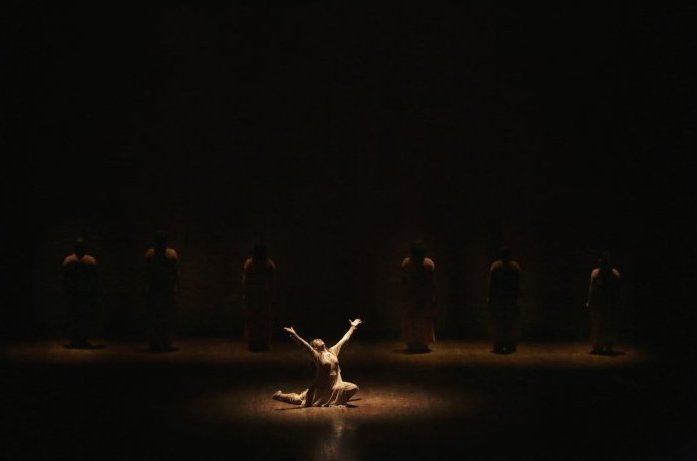
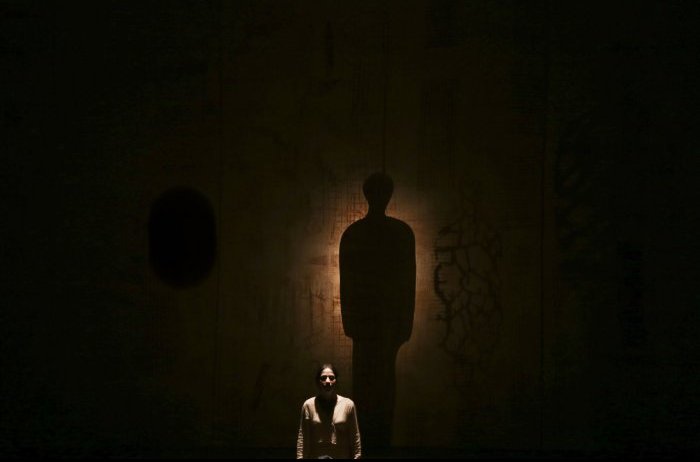 Photo: Nirvair Singh We continue to admire and applaud Aditi. At 56, this Kathak superstar has stirred the traditional pot of her learned art. She has infuriated purists, rejected a national award and doggedly pursues her search for a new language from the scaffolding of her beloved classical form. Partnering with British visual and choreographic enablers, Aditi has now become the global name from India for superb visuals, great dancing and a relentless adherence to international professional standards. With an enviable touring calendar that is carrying her to Russia, Eastern Europe and the UK, Aditi's new collaboration mantra seems to have helped her break through the largely Anglo Centric world of international presenters and curators. Her newest production INTER-RUPTED brought together dramaturg Farooq Choudhury, mentor Morag Deyes, costume designer Kimie Nakano (realised by Sandhya Raman), lighting artist Fabiana Piccioli and producer Anand Bhatt. Premiered at the NCPA TATA THEATRE, the ticketed show was almost housefull - a separate testament to her popularity in the city of her birth. Superb visuals, gorgeous lighting and tightly rehearsed dancing were all on display. What was not revealed through the over verbalisation of program notes was the concept. Breath was the leitmotif of the work. Interrupted breath, breaks in thought, fragments of life told through the metaphor of the rolling dice. The opening visual of a long swathe of black fabric, doubling as unbound hair, sweeping the stage floor while a dancer slowly crawled face down, was a Butoh moment. As the work unfolded, what emerged was an incohate series of scenes, nothing resolved and mostly a simplistic harking back to traditional Kathak riffs. Musicians awkwardly tiptoeing onto the stage, a singer walking in and then sitting down in an incongruous moment, sudden bursts of traditional "nritta" that ended on the "sam" final beat, all pointed to a retreat into "safe zones." Talking to other choreographers after the show, I was told that Western audiences prefer less choreography and more repetitions so they can 'get it'. No matter what the viewing lens may be, the post performance discussion (moderated by yours truly) showed that Aditi was still looking to shape the work which was better as a visual document and photo spread than a choreographic tour de force. My personal feeling was that there were too many "cooks' for INTER-RUPTED. And that could have made this work falter between two continents. INTER-RUPTED tours the UK this month and responses should be interesting. This is a must see show for all dancers to look beyond the large budget, expensive set and lighting costs to see the formula that works for large international festivals and expansive stages around the world today. #LIVING GODDESS - VYJAYANTIMALA - New Delhi 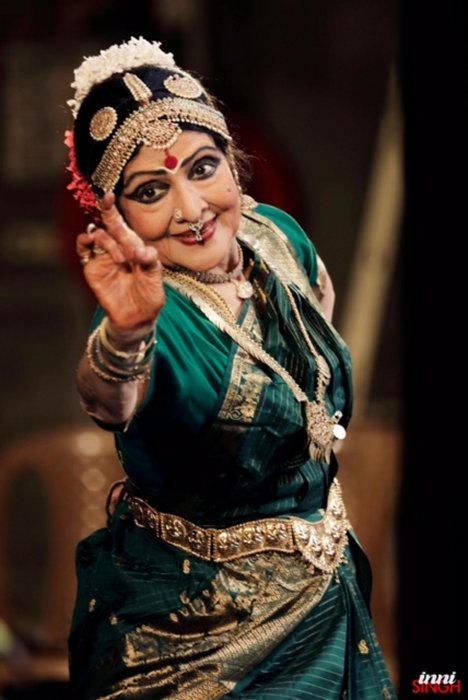
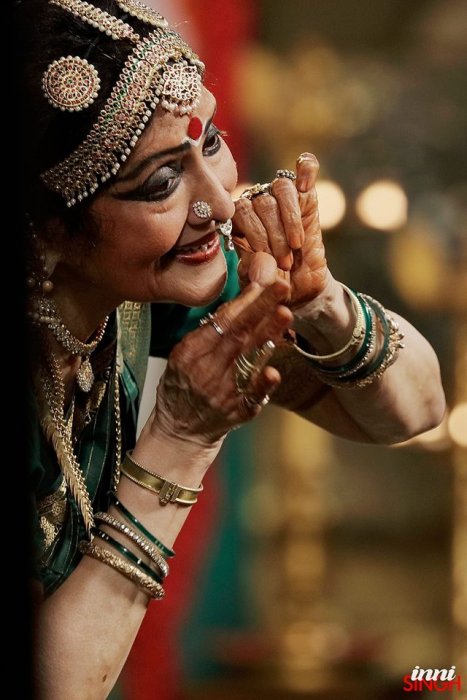 An answer to extravagant set and production design markers came from an 83 year old artiste extraordinaire. Clad in emerald green - the colour of her favourite and personal deity AANDAAL - Vyjayantimala was a blaze of luminance at her command performance in the nation's capital. Serene, unhurried and supremely in control, she took charge from the very first time the lights came on. Spontaneous applause at her unblemished aura of more than 60 years in cinema and stage, Vyjayantimala revealed what a deep understanding of classical dance could mean to someone who is immersed in the music, ideas and history of the form. I recall a scene from 25 years ago when a small group of us sat in the living room of N Pattabhiraman, the founder of Sruti magazine. The point of debate was the changing contours of Bharatanatyam. Among the group were revered gurus like Adyar K Lakshman, Dhananjayans, Narasimhacharis, Kalanidhi Narayanan, Sudharani Raghupathy and others. Kalanidhi mami blamed “modern interventions" into the form while looking directly at me. I do not recall other moments except the strident voice of Vyju Akka who claimed that "Bharatanatyam was a sacred art and tampering and tossing it around like a plaything was not in good taste". This statement can be interpreted in various ways in the new millennium but her firm stand on the personal conversation she maintains with her art form cannot be questioned. Trim and svelte in her 9th decade, Vyjayantimala's performance came as a reminder to all those who claim to love Bharatanatyam but who substitute simpering, posing and cloying "abhinaya" for excellence. #QUEEN SIZE - Mandeep Raikhy - New Delhi 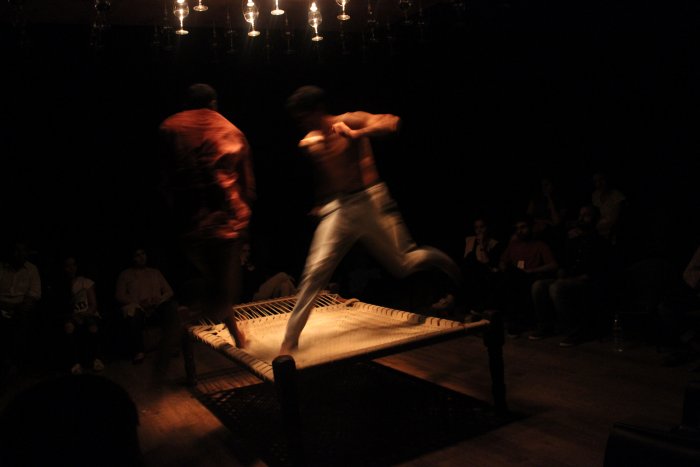 Photo: Sidharth Sarcar Performing gender is always a slippery slope to navigate. Transgender, gay, lesbian issues are more and more front and centre of mainstream media and several dancers and choreographers outside India have used their personal histories as grist for the choreographic mill. A famous work created by BILL T JONES for his partner Arnie Zane who died of AIDS was called STILL HERE/NOW featuring dancers against a large screen of dying AIDS victims. The work created a furore in the USA 20 years ago, with noted critic Arlene Croce of THE NEW YORKER publicly refusing to review it by calling it PITY ART. Here in India, most dancers hide their sexualities fearing an exodus of students and other forms of banishment. Navtej Johar has perfumed his choreographies by exploring the interstices of male and female-ness without any overt statements. His FRENEMIES and MEENAKSHI were explorations in alternate viewpoints that illuminated his own androgynous persona and brought a new aesthetic to classical and contemporary audiences. A more direct response to article 377 of the Indian Penal Code that criminalises homosexuality is Mandeep Raikhy's QUEEN SIZE. Using the presence of the audience as a trigger, two dancers use a bed and change positions, suggesting love play and a metaphoric gauntlet thrown down to tunnel-visioned right wing purists. While we are waiting for responses to the work, it is heartening that Mandeep has not been arrested, handcuffed or restrained in any way to make and present the work. #INKED OUT OF EDUCATION - CURRICULUM - UK The new education guidelines for UK schools do not include the arts stream as an option at the high school level. Ann David, Head of Dance at Roehampton University, shares her alarm at this development which, she feels, will even further impoverish those students who may want to join creative communities as a professional career choice. If the arts are not made compulsory in school then how can they make an informed choice when they graduate? Here in India, the arts are being gradually incorporated into several curricula and left brain thinking corporates are being introduced to theatre, improvised storytelling and team building via the arts. Chennai based theatre company EVAM has a lucrative wing called SIDEWAYS TRAINING which concentrates on interfacing with manufacturing businesses and software companies who stare at machines and computer screens all day while marketing and sales departments plot about how to attract more customers. The international Baccalaureate and ICSC syllabus allows students to take up music, dance, painting instead of maths and economics after 10th standard. Dance education is, however, a whole new area of study. While dance continues to struggle for recognition and acknowledgment, dancers need to pay more attention to the concept of THEORY and ANALYSIS even as they mature in their practices. The notorious attitude of looking down on dance academia is not relevant any more since only a handful of dancers command attention and respect without accompanying articulation. Look and listen to the glib pronouncements of Akram Khan after one of his many performances. He can sit in any way, say anything, however outrageous, and people lap it up. That sort of smarts comes with hundreds of opportunities of interacting and engaging with a variety of audiences around the globe. In India, Aditi mounted her INTER-RUPTED for a single show and was unable to articulate much in the discussion. While I am not holding Akram's example as one to follow, it is to show that the more dancers are asked about intention, structure, dramatic arcs and kinetic sensibilities, the more lucid and convincing the answers can be. #INDIAN INDEPENDENCE - UNITED NATIONS BLOOPER 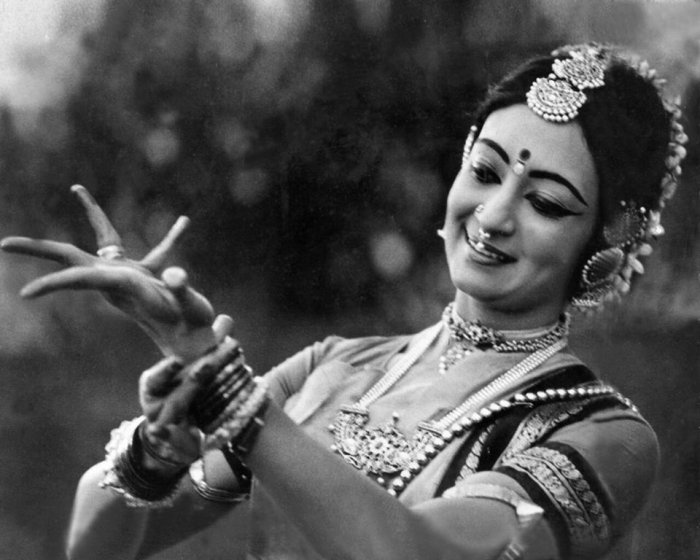 DANCER Sudharani Raghupathy performs for HUMAN RIGHTS DAY at United Nations, New York December 1981 The 70th Independence Day was commemorated at New York's United Nations headquarters with the music of Oscar winning composer AR RAHMAN. Before Rahman, the names of Carnatic music vocalists Sudha Raghunathan and Bombay Jayashri were floated. Previous artistes who were featured at the august event at the GENERAL ASSEMBLY auditorium were M S SUBBALAKSHMI in 1966, VYJAYANTIMALA in 1969 and SUDHARANI RAGHUPATHY in 1981. For MS, Pontiff of Kanchipuram wrote the now famous Sanskrit song MAITRIM BHAJATA advocating non violence. For Sudharani Raghupathy's appearance, national award winning musician MADURAI N KRISHNAN tuned a Sanskrit verse AKASHAT PATITAM TOYAM, extolling nature and the value of peace. Rahman was a surprise last minute choice, overturning the classical musicians who were all set to travel. That the national anthem was not played on the occasion and a range of bland melodies were chosen has left many puzzled and outraged at the Indian government's clumsy handling of an important occasion. #AUGUST - MADRAS WEEK AND RIO OLYMPICS The month of August is the month that the city of MADRAS was born. 377 years ago, a small fishing village was named MADRAS and recently renamed CHENNAI.The month had a calendar brimming with talks, walks and humourous storytelling of important landmarks and moments in my home town's colourful history. After all, the British entered through this fishing village "to trade" and established the jewel in their crown for more than 3 centuries through this entry point.. August was also the month in which we saw the glory of the BODY IN PLAY. Through 2 fascinating weeks, the world watched in awe as more than 2000 athletes from various countries competed for their countries. Wearing their nationalities proudly on their arms, chests and legs, men and women showed us the glory of the human body. What grace, precision and finesse they displayed. What spirit, camaraderie and empathy. While records were broken and the Indian women shone in an otherwise dismal scenario for the country, I could not help thinking about how wonderful it would be if music and dance were included so India could have had a less miserable showing. That fanciful thought aside, what fascinated me was the grit and ferocious ambition of the Indian women who made us sit up and take notice. Badminton, golf, wrestling and gymnastics were the four areas where great strides were made. A cricket crazy nation tuned into these women's attempts while politicians fought over whose state they belonged to. The most searched category for silver medallist PV SINDHU on google was - CASTE! YES. PV SINDHU-CASTE. Some things never change. Sadly. 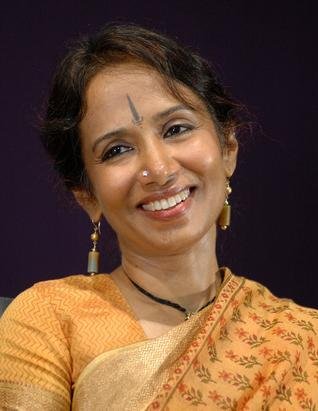 Diva and evergreen teenager Alarmel Valli turns 60 this month. An Internatioinal star and an audience magnet, here's wishing this Bharatanatyam and dance icon health and creativity for few more decades. And so it goes... Dancers continue to blaze across stages and seas in diverse forums- bringing both skill and tradition each time they move. Without wearing a country's name on their chests or a sponsor's logo on their costumes, they still succeed in bringing attention and applause to their art and heritage. While watching the exhibition of Indonesian KULA RINGS in the foyer of THEATRE WORKS in Singapore, I wondered if we could rethink the ideas of circulation and currency without commerce and profit propagated by the current economic systems. How can we create and share art without the intense paranoia and insecurity that seems to gnaw at our innards? Are there ways in which art AND commerce can coexist without the goalpost of competition and the idea of a winner and loser like in sports? Anita R Ratnam Chennai/ London/ New York PS: Received a phone call from a distraught Chennai sabha secretary. The object of his ire was the Madras Music Academy. “When this organisation programs a mere 2 weeks of classical music and one week of dance in the whole year, how is it that they still have the prestige and acclaim of the best sabha in the city? Here I am, having programmed 400 shows, several awards and citations through 2015 with nothing to show but losses and poor crowds!” Twitter: @aratnam Facebook: Anita R Ratnam Instagram: @anitaratnam Blog: THE A LIST / anita-ratnam.blogspot.in Post your comments |